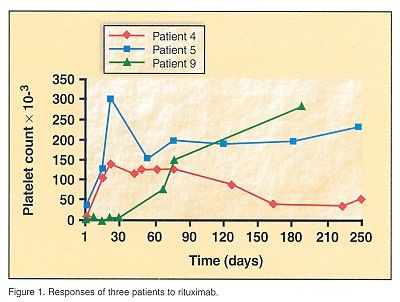Rituximab Produces Clinical Responses in Even Steroid-Refractory Idiopathic Thrombocytopenic Purpura
BIRMINGHAM, Alabama-Idiopathic thrombocytopenic purpura (ITP) may respond to rituximab (Rituxan) monoclonal antibody treatment, even in steroid-refractory patients, investigators reported in a poster presentation.
BIRMINGHAM, AlabamaIdiopathic thrombocytopenic purpura (ITP) may respond to rituximab (Rituxan) monoclonal antibody treatment, even in steroid-refractory patients, investigators reported in a poster presentation.
Mansoor N. Saleh, MD, said that rituximab at 375 mg/m2 weekly for 4 weeks was well tolerated and produced clinical responses in 3 of 17 patients, including one complete response (CR) lasting more than 6 months. Dr. Saleh is professor of medicine at the University of Alabama Comprehensive Cancer Center in Birmingham and director of research development at Georgia Cancer Specialists, Inc., in Atlanta.
"ITP is characterized by autoantibody-mediated thrombocytopenia in the presence of increased bone marrow megakaryocytes," Dr. Saleh explained. "The culprit autoantibody is most frequently IgG and/or IgM, although other antibody subclasses have sometimes been implicated. Treatment generally consists of attempts to inhibit autoantibody production with steroids or immunosuppressive agents, to increase bone marrow platelet production with steroids or androgens, or to inhibit platelet opsonization with splenectomy, intravenous gamma globulin, or vincristine. Since autoantibodies are generally produced by polyclonal CD20+ B cells, inhibiting autoantibody production often results in platelet recovery. The chimeric anti-CD20 monoclonal antibody rituximab effectively depletes CD20-expressing B cells, suggesting that it might affect autoantibody production and be beneficial in ITP," he continued.
Standard Dose Well Tolerated
All patients in this dose-ranging study had a clinical diagnosis of ITP, platelet counts less than 75,000, had failed steroids or were unable to maintain platelet counts greater than 75,000 at tolerable steroid doses, and had bone marrow with increased numbers of megakaryocytes.
Complete response (CR) was defined as a platelet count greater than 100,000 for at least 4 weeks post-therapy. Partial response (PR) was defined as a platelet count of over 70,000 without steroid maintenance or of over 100,000 with steroid maintenance.
No responses were seen in patients treated at the lowest rituximab dose level (50 mg/m2 on day 1 and 150 mg/m2 on days 8, 15, and 22). Two of the three responses to rituximab (see Figure 1), including the only CR, occurred in the two patients treated at the second dose level (150 mg/m2 on day 1 and 375 mg/m2 on days 8, 15, and 22). Both of these patients had previous splenectomy, and both responses had durations of 6+ months at the time of this report.

Of the 10 patients at the full dose level, 1 achieved a partial response with a duration of 3+ months. This patient’s prior therapy had included steroids, Prosorba, WinRho, and intravenous IgG, but not splenectomy. Three additional patients at this dose level have not completed the treatment course.
"Standard-dose rituximab was well tolerated in patients with ITP. Three of 17 patients treated at or near full dose demonstrated a clinical response," Dr. Saleh reported. Two of the three responders had previously failed splenectomy. "Platelet responses occurred up to 4 weeks following therapy. Surprisingly, clinical response was not associated with normalization of platelet-associated antibodies. The basis for the clinical response to rituximab remains to be elucidated, as does the role of factors such as previous splenectomy. A study of rituximab in ITP patients who have failed splenectomy is currently underway."